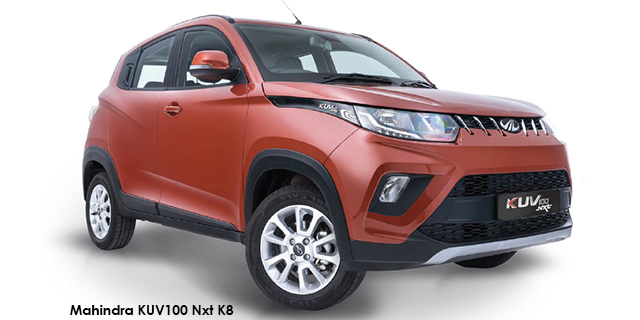With the release of the KUV100 Nxt, Mahindra seeks to build on the success of its city crossover. Has it succeeded?
Since making its local market debut in 2016, the KUV100 has become the bestselling passenger car in Mahindra’s range. The Indian firm recently introduced a number of changes to its popular KUV (Kool Utility Vehicle, if you were wondering) line-up. Over and above the addition of the Nxt suffix, updates include aesthetic revisions, new features and the introduction of an entry-level K2 derivative. The model tested here is the facelifted version of the flagship G80 K8, of which a test appeared in our August 2016 issue.
The G80 K8 features the latest interpretation of Mahindra’s seven-slot grille, replete with vertical chrome slats that plunge towards the redesigned front bumper, to give the sharply styled crossover an even more distinctive look; quite an eye-catching update, testers noted. Dual-chamber headlamps (adorned with boomerang-shaped daytime-running lights), foglamps fore and aft, and an integrated rear-spoiler add to the package. Seeing as this is the top-of-the-range KUV100 Nxt, 15-inch two-tone alloy wheels have replaced the comically small 14-inch items that were fitted to the previous model.
But what distinguishes the G80 K8 most from other models in the line-up is its updated interior. Although not fitted to the photo-graphy car seen here, the flagship version features a new seven-inch touchscreen infotainment system equipped with Bluetooth 4.0 connectivity, video playback, integrated satellite navigation and a trip computer. In conjunction with the rear park-assist system, which displays the vehicle’s exact distance (in centimetres) from an obstacle behind it, the K8 employs a reverse-view camera providing helpful assistance when you need to manoeuvre the Mahindra out of a tight parking space. Air-conditioning is standard too and it works ... almost too well; one tester jokingly compared the blower’s lowest setting to the unleashing of a gale-force wind. Like its predecessor, the facelifted KUV100 Nxt’s facia is reasonably solidly assembled but some buzzes did emerge as the rev needle climbed past the 3 000 r/min mark.
Up front, headroom remains generous; even with this small crossover’s elevated seating position, which testers applauded, taller occupants don’t need to fear they’d bump their scalps against the Mahindra’s roof lining with regularity. Given the KUV100 Nxt’s compact dimensions, rear passengers are afforded relatively ample legroom but that does result in a compromised luggage capacity of only 128 litres. A storage compartment, neatly hidden in the rear cabin floor, can be used to stow valuables, plus if you fold the one-piece aft backrest down, 960 litres of utility space is available.
The gearlever, which is still sited next to the steering wheel (as it was on the outgoing model), remains effortless to use and again received positive comments from the CAR team for its slick shift quality. One tester remarked the steering is somewhat vague and required improvement, but the G80 K8 was commended for its impeccable turning circle. Given the car’s up-on-stilts stance (and, therefore, elevated centre of gravity), corners should be negotiated with some circumspection. Testers also found, when the test unit travelled above 100 km/h, especially in strong winds, it required a fair level of driver involvement to keep the K8 tracking steady.
The mFalcon G80 petrol engine, which came in for criticism when we first tested Mahindra’s crossover, remains unchanged, and produces 61 kW and 115 N.m of torque. The 1,2-litre three-pot feels rough at idle and its performance is not particularly spirited, which can make reaching the national speed limit feel like a bit of an accomplishment. This means overtaking should be done only after each variable is carefully considered. The D75 oil-burner, employed by both K6 and K8 diesel derivatives, might then be the better engine choice thanks to its punchy 190 N.m at a low 1 750 r/pm.
In the G80 K8’s defence, the small crossover’s suspension, which affords a ground clearance of 170 mm, soaks up road irregularities with aplomb. We expect the Mahindra to be particularly well suited to repeated use on unkempt road surfaces and even gravel routes. Although fitted with ABS and EBD, the G80 K8 managed to achieve an average stopping time of 3,41 seconds, which resulted in it getting a “poor” rating by our road test standards.
The as-tested fuel consumption of 7,08 L/100 km remains impressive, with the 35-litre fuel tank, if small compared with the 50-litre capacity of the Renault Sandero Stepway, for example, allowing the K8 to travel some 500 km before refuelling is required.
TEST SUMMARY
Once again, the KUV100 Nxt's slightly stodgy engine is its Achilles heel but there's not much else to complain about. If the Mahindra's primary purpose is to be used for city driving, it gets harder to fault this small crossover. The G80 K8 offers ample standard features, slick gearshifts and a cabin that is reasonably well out together.
That said, the R200 000 price tag may put off some buyers who would favour a more traditional brand. To that end, Mahindra was smart to introduce a G80 K2 base derivative to this line-up. Although obviously not as generously specced as the K8 version, it's still a bang-for-your-buck city car...
*From the February 2019 issue of CAR magazine
ROAD TEST SCORE

|
Original article from Car
See Full Mahindra KUV100 Nxt price and specs here












